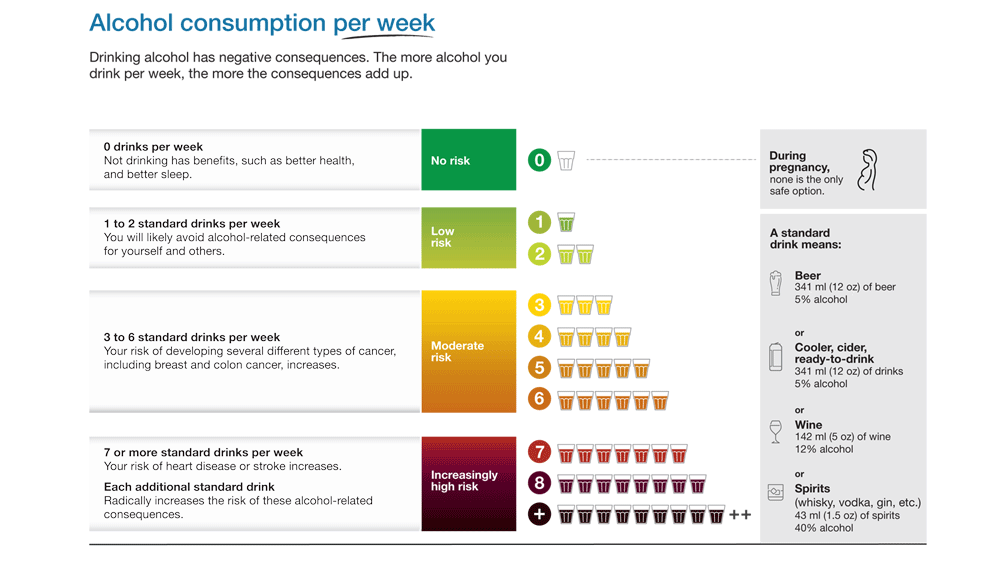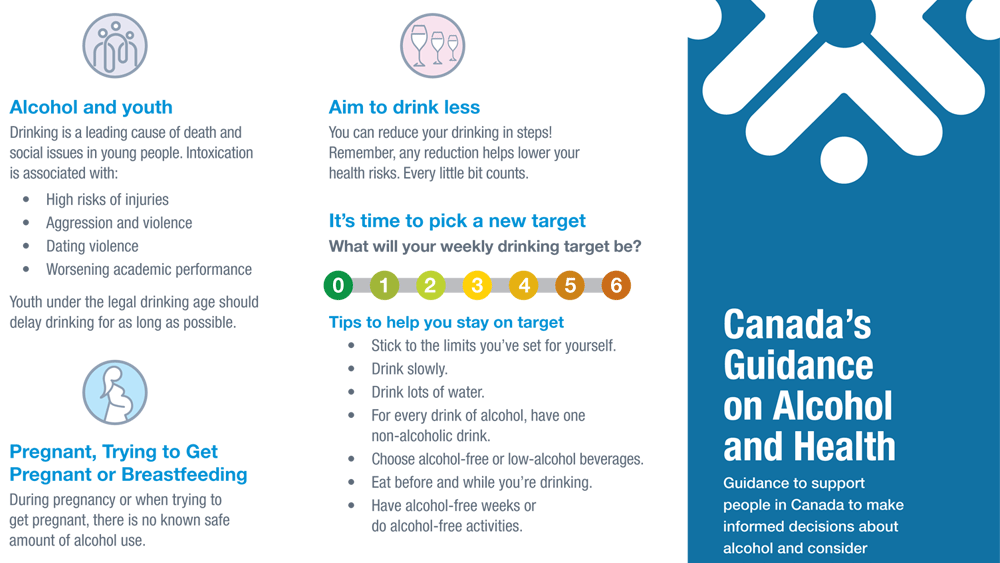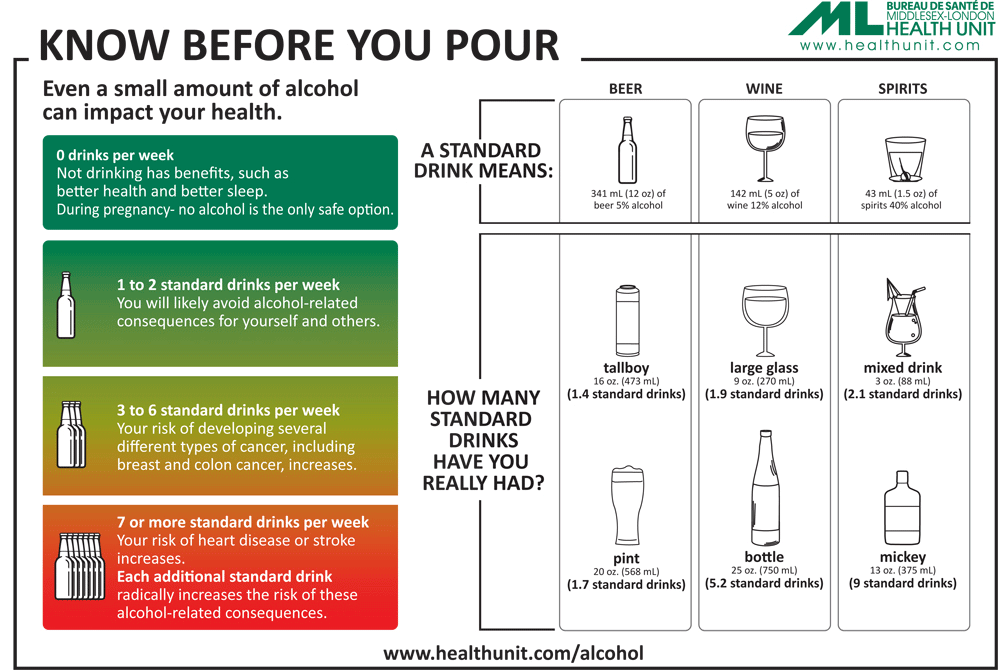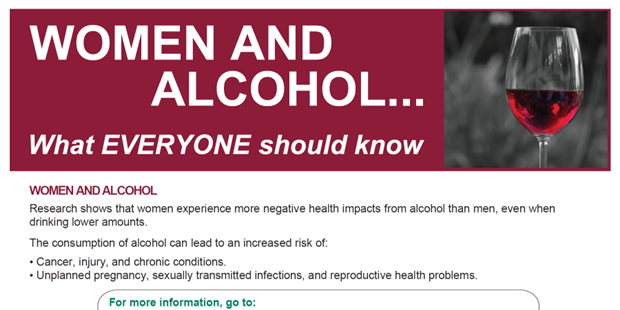Alcohol
Alcohol is the most widely used substance in Middlesex-London but it is not a harmless substance. Many individuals drink at levels that increase their health risks.
Canada’s Guidance on Alcohol and Health
In January 2023, The Canadian Centre on Substance Use and Addiction (CCSA) released Canada's Guidance on Alcohol and Health that replaced the 2011 Low-Risk Alcohol Drinking Guidelines. This new guidance was created to help individuals make informed choices about their own health and alcohol consumption.
The guidance provides evidence-based information to Canadians of legal drinking age, including:
- Definitions of what a standard drink is,
- Alcohol-related health risks, including cancer,
- A continuum of risk associated with average weekly alcohol consumption (low, moderate, and increasingly higher risk), and
- Tips to reduce alcohol consumption.
Cutting down on how much you drink will reduce your risk of alcohol-related problems.
Alcohol, even in small amounts, increases an individual’s health risk including at least 7 types of cancer, cardiovascular disease, liver disease, injury, and violence. The newest evidence confirms a clear continuum of risk associated with average weekly alcohol use, where the risk of harm is:
- Low for individuals who drink 2 standard drinks or less per week;
- Moderate for those who drink between 3 and 6 standard drinks per week; and
- Increasingly higher for those who consume 7 standard drinks or more per week.3
No matter where you are positioned on the continuum of risk, remember that any reduction in the number of drinks you have in a week will provide benefits.
- If you choose to drink alcohol, try to keep it to no more than 2 standard drinks per occasion to reduce the risk of harm to yourself and others.
- When pregnant or trying to get pregnant, there is no known safe amount of alcohol use. Click for more details.
- When breastfeeding, not drinking alcohol is safest.
- If you are concerned about how much alcohol you are drinking, consider getting help.
Reduce Your Risks
Drinking less alcohol can be challenging but reducing the amount you consume is better for your health. Here are some ways to help.
- Understand what a standard drink is so that you can accurately determine how much alcohol you are drinking in a week.
- Follow the limits you have set for yourself.
- Drink slowly.
- Drink lots of water.
- For every drink of alcohol, have one non-alcoholic drink.
- Choose alcohol-free or low-alcohol beverages.
- Eat before and while you are drinking.
- Have alcohol-free weeks or do alcohol-free activities.3
- Get help if you are concerned about the amount of alcohol you are drinking.
Standard Drink of Alcohol
What is a Standard Drink of Alcohol? Many people are surprised to learn what counts as an actual drink. In Canada, a "standard drink” is any drink that contains 13.45 grams or 17.05 mL of "pure" alcohol. Know what a standard drink is so that you know how much alcohol you are actually drinking.3
One Standard Drink Equals:
- 341 ml (12 oz) bottle of 5% alcohol beer, cider or cooler
- 43 ml (1.5 oz) shot of 40% hard liquor (vodka, rum, whisky, gin, etc.)
- 142 ml (5 oz) glass of 12% alcohol wine
Remember that high alcohol % beers, coolers, cider and fortified wines contain more than one standard drink. 3 Watch this video to learn more →
Alcohol Risks
Short Term Health Risks
Alcohol use, especially binge drinking, has immediate effects that increase the risk of harm including:3 4
- Unintentional injuries - Traffic injuries (drinking and driving), falls, drowning, burns, and unintentional firearm injuries.
- Alcohol poisoning - A medical emergency that results from high blood alcohol levels that can cause passing out, low blood pressure, low body temperature, coma, problems breathing, or even death.
- Violence - Fights, family violence, and child abuse.
- Sexual health - Increased unprotected sex which can lead to unintended pregnancy and/or sexually transmitted infections. Sexual impotence, hormonal irregularities, and infertility.
Long Term Health Risks
Over time, alcohol use can lead to the development of many physical, emotional, mental, and social problems including:3 4 5
- Cardiovascular Disease - Heart attack, heart disease, high blood pressure, and stroke.
- Cancer - Cancers of the head & neck, liver, colon, and breast. In general, the risk of cancer rises with increasing intake of alcohol. If you drink & smoke cigarettes, the risk of developing certain cancers is even greater.
- Liver Disease
- Mental health - Alcohol dependence, depression, anxiety, and suicide.
- Personal/Social difficulties - Unemployment, financial crisis, and family/friend conflict.
- Damage to organs - Liver, brain, heart, and stomach
Women and Alcohol
Women are more vulnerable than men to alcohol, especially when drinking above the upper limit of the moderate risk zone (6 standard drinks/week) for alcohol consumption as per the Canadian Guidance on Alcohol and Health. Overall, women are more likely to exhibit major health problems related to alcohol in a shorter period of time.3
Biological factors including body weight and size, genes, enzyme levels, organ function, and metabolism all impact how alcohol affects women. These differences result in higher blood alcohol levels, faster intoxication, and more risk for harm including breast cancer, liver damage and injury.3 6
Alcohol and Cancer
Alcohol has been classified as a group 1 carcinogen (causes cancer in humans) since 1988. It increases the risk of at least 7 types of cancer and has been linked to approximately 7,000 new cancer cases in Canada each year. Reducing the amount of alcohol, you drink will decrease your alcohol cancer risk level.3
Alcohol and Pregnancy/Breastfeeding
The Canadian Guidance on Alcohol and Health provide clear direction when it comes to pregnancy and breastfeeding. When pregnant or trying to get pregnant, there is no known safe amount of alcohol use. When breastfeeding, not drinking alcohol is safest.3
Older Adults and Alcohol
As individuals age, it is important to remember that alcohol affects bodies differently.
- People become more sensitive to the effects of alcohol as they get older
- Drinking alcohol can make some health problems worse
- Mixing alcohol and medication can be dangerous as it can cause serious side effects 3 5
Review the Canadian Coalition for Seniors’ Mental Health’s resource Alcohol & Aging – Rethink How You Drink to learn more about alcohol and aging.
Effects of Alcohol on Older Adults
In general, older adults do not drink as much as younger people but as we age alcohol is processed more slowly in the body and individuals can become more sensitive to alcohol’s effects. This is because older adults' blood circulation, kidneys, and liver work more slowly to eliminate alcohol and their bodies contain less water to dilute alcohol. These factors make older adults more at risk for:
- Decreases in muscle control
- Decreases in muscle strength
- Loss of balance
- Loss of co-ordination
All of these issues put older adults at risk for injuries due to falls. 3 7
Alcohol Can Make Some Health Problems Worse
Alcohol travels through the bloodstream to every organ in the body which means alcohol can affect every organ in the body. Drinking alcohol increases your risk of developing several health problems including certain cancers, heart issues, liver disease, alcohol dependence, mental health problems, and injuries. If an older adult is already living with a physical or mental health problem, alcohol can actually make that health problem worse.3 7
To decrease your risks related to alcohol as you age, consider drinking less alcohol. Check with your healthcare provider regarding your current alcohol consumption.
Many older adults take medications including prescription drugs, over-the-counter medications, and herbal remedies. Drinking alcohol while on medication can put you at dangerous risk and can cause the medication to not work properly. Problems mixing alcohol and medicine can include:
- Serious medical problems like bleeding, breathing difficulties and heart problems
- Increasing side effects of medication like nausea/vomiting, drowsiness, dizziness, loss of balance and confusion
- Making the medication less effective or completely useless 3 7
It is important to remember that medication can stay active in your body for a long time – so even if you drink alcohol several hours after you take your medication, it can still have a negative effect.
Speak with your healthcare provider and pharmacist about drinking alcohol while on any medication including prescription, over-the-counter, and herbal remedies.
Get Help
If you have decided, for whatever reason, that you need help with your alcohol or other drug use, there are many resources and sources of support available. You are not alone.
Talk to your healthcare provider about:
- how much you are drinking or using drugs
- ways to reduce your risks
- what resources may be available to you in your community
Contact Connex Ontario or Reach Out

- ConnexOntario provides service information and resources for people experiencing problems with gambling, drugs, alcohol, or mental health. The service is free, confidential, and available anytime. Call ConnexOntario 24/7 for live community support and services at 1-866-531-2600. Text “connex” to 247247 or chat with us at www.connexontario.ca.
- Reach Out (1-866-933-2023) is a free, 24/7, confidential mental health and addictions support and services line for people living in Elgin, Middlesex and Oxford and London. If you need mental health and addictions help, Reach Out is the one service you should connect with.
Substance Use Services in Middlesex-London
There are a variety of Substance Use Services in the Middlesex-London area to help address alcohol and/or other drug concerns.
Last modified on: February 23, 2024
References
https://www.ccsa.ca/canadas-guidance-alcohol-and-health-public-summary-drinking-less-better-infographic
https://www.ccsa.ca/canadas-guidance-alcohol-and-health-public-summary-drinking-less-better-brochure
https://www.ccsa.ca/sites/default/files/2023-01/CCSA_Canadas_Guidance_on_Alcohol_and_Health_Final_Report_en.pdf
https://www.canada.ca/en/health-canada/services/substance-use/alcohol/health-risks.html
https://www.camh.ca/en/health-info/guides-and-publications/alcohol-and-chronic-health-problems
https://ccsa.ca/sites/default/files/2022-08/CCSA-LRDG-Sex-Gender-and-Alcohol-what-matters-for-Women-in-LRDGs-en.pdf
https://ccsmh.ca/wp-content/uploads/2023/05/V1-CCSMH-Alcohol-use-Brochure.pdf




